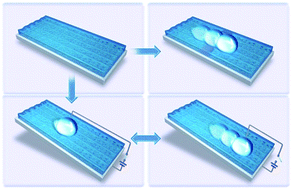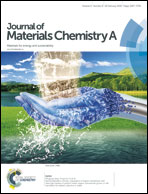Effect of lubricant viscosity on the self-healing properties and electrically driven sliding of droplets on anisotropic slippery surfaces†
Abstract
The emerging slippery liquid-infused porous surfaces inspired by Nepenthes pitcher plants have attracted considerable attention because of their excellent self-cleaning properties and potential applications in novel microfluidics, microchips, and liquid transportation and liquid manipulation technologies. However, the development of anisotropic slippery surfaces is in its infancy. Although some information of anisotropic slippery surfaces has been reported, the factors influencing their self-healing properties and electrically driven droplet motion have not been deeply explored. To address this limitation, anisotropic slippery surfaces have been designed and prepared with directional, porous and conductive PCDTPT films and lubricants (silicone oils with different viscosities), which are used here to investigate the influencing factors of the self-healing properties and electrically driven droplet motion. The results elucidate that the critical self-healing thickness increases with increasing silicone oil viscosity and that low-viscosity silicone oils filling in the porous films can reduce the responsive voltage of the electrical control of droplet motion on the anisotropic slippery surfaces with the same lubricant layer thickness.



 Please wait while we load your content...
Please wait while we load your content...